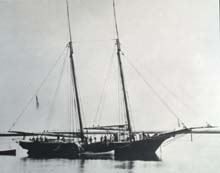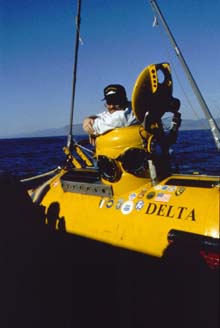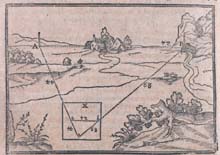September 21, 2001 - Web Chat
2:00 - 3:00 PM Eastern Time (11:00 - 12:00 PM Pacific Time)
Preserving Our Submerged Cultural Resources
Join the Chat Room to leave a question!
Introduction
Panel of Experts
Preparation
Online Classroom Activities
Challenge Questions
Win a free Sustainable Seas Patch!

Shipwrecks and other submerged cultural resources provide present day man with a window into past cultures.
There is a common misperception among the public that ancient shipwrecks rest upon the bottom of the seabed looking as complete as if they sank yesterday and that they are all brimming with treasure chests full of jewels and coins, just ripe for the picking! The reality is quite different. Through the emerging science of underwater archaeology we are now learning that wooden ship remains rarely sit proudly on the sea bed. They are more often, a fragmentary jumble of decayed wooden timbers or iron, often covered with mud, sand, shells and sea grass. All of that dreamed-about treasure is, likewise, a rarity. The true treasure is the knowledge and insight that a shipwreck and its remains may provide us into our past.
The underwater environment permits the preservation of types of artifacts that rarely survive in land sites. Organic materials such as wood, fabric, leather, and even hair are often preserved in the anaerobic environment of submerged sediments. Such amazing artifacts as books, clothes, wooden tools, musical instruments and ship structure have been recovered from shipwreck sites that are hundreds of years old and tell us volumes about the material culture of our forebears. Shipwrecks are time capsules that can represent the society of a ship’s crew as well as link disparate societies. Ships often traded between two distant cultures and the artifactual remains of their cargoes tell us about the exchange of goods as well as ideas and culture.
Archaeology is, inherently, a destructive process. It is the systematic dismantling of a historic or prehistoric site in order to reconstruct on paper or computer, as nearly as possible, that site’s original configuration. For this reason, it must be done carefully and precisely while keeping detailed records. Not only does archaeology seek to revive past structures and artifacts, but the vibrant cultures and lives of the people who made and used those artifacts.

John D. Broadwater
John D. Broadwater has been Sanctuary Manager of the NOAA's Monitor National Marine Sanctuary since April 1992. In that capacity, he has directed five major expeditions to the remains of the Civil War ironclad USS Monitor, in 240 feet of water, 16 miles off Cape Hatteras, North Carolina. During 1978-90, as Virginia's Senior Underwater Archaeologist, he directed the Yorktown Shipwreck Archaeological Project, a study of shipwrecks from the 1781 Battle of Yorktown (Virginia). During that same time period he also developed a statewide underwater archaeology program for the Virginia Department of Historic Resources. In 1996 he published a five-volume report on the Yorktown Project, the focus of which was the excavation and interpretation of the Betsy, a 180-ton British collier built in 1772 in Whitehaven, Cumberland (now Cumbria), England.
John has served as crew on several square-rigged vessels, including the 19th-century brigantine Explorer and the 17th-century replicas Dove and Godspeed. He served as Mate on the Godspeed’s trans-Atlantic crossing from London, England to Jamestown, Virginia in 1985.
He has participated in numerous national and international underwater archaeological expeditions and serves as a member of the Advisory Council on Underwater Archaeology and other advisory boards. He has published a variety of technical and popular articles, including "Secrets of a Yorktown Shipwreck" in the June 1988 issue of National Geographic Magazine. He has a master’s degree in American Studies from the College of William and Mary, and a Ph.D. in Maritime Studies from the University of St. Andrews, Scotland.

Robert V. Schwemmer
Electrophysiology
Robert V. Schwemmer is currently the Cultural Resources Coordinator for NOAA’s, Channel Islands National Marine Sanctuary and the Santa Barbara Maritime Museum. His responsibilities include maritime research and development of shipwreck exhibits correlating to the Sanctuary and Santa Barbara region. Schwemmer coordinates and perform archaeological resource studies for the Sanctuary including recording and mapping submerged sites. He is also engaged in maritime research as a consultant to Federal and State Government agencies, including private and non-profit organizations. Past projects have included systematic research in developing shipwreck assessments for the Channel Islands National Marine Sanctuary and National Park, and Olympic Coast National Marine Sanctuary, and Dry Tortugas National Park. Deepwater projects include submersible work aboard Delta to perform site assessment of the shipwreck Montebello located in 900 feet off Cambria, California. Charter member and past President of the Los Angeles Maritime Museum Research Society. Currently Vice-President of research for the Coastal Maritime Archaeology Resources (CMAR) organization.
Preparation
To help you prepare for the live event on September 21, the Islands in the Stream Education Team has provided some pointers to Web sites where you can learn more about the importance of shipwrecks, as well as participate in online classroom activities.
We challenge you to answer some questions and hope that as you explore the suggested Web sites for answers and conduct the related activities, you will come up with some questions of your own to ask our experts, John and Bob. We invite you to leave your own questions in the chat room before the event, or ask them during the live program.
Online Classroom Activities
Shipwrecks in the U.S. National Marine Sanctuaries ![]()
NOAA's Office of National Marine Sanctuaries collaborated with the BRIDGE ![]() to provide an online lesson plan about shipwrecks, a type of submerged cultural resources. You can learn about shipwrecks and how they can teach us important lessons on how currents, weather, technology and human error can combine in ways that can damage the environment.
to provide an online lesson plan about shipwrecks, a type of submerged cultural resources. You can learn about shipwrecks and how they can teach us important lessons on how currents, weather, technology and human error can combine in ways that can damage the environment.
Bringing Our Historical Past Through Shipwrecks ![]()
The Channel Islands National Marine Sanctuary has been working in partnership with the BRIDGE to provide teachers and students with an online educational activity to learn more about important shipwrecks found within the 5 national marine sanctuaries (Channel Islands, Monterey Bay, Cordell Bank, Gulf of the Farallones and Olympic Coast) on the West Coast of the United States
This Web site includes the following educational resources:
West Coast National Marine Sanctuary Shipwreck Database ![]()
U.S. Coast Guard Glossary of Nautical Terms
Latitude: The Art and Science of Fifteenth Century Navigation ![]()
Challenge Questions
Name four ways ships end up at the bottom of the ocean.
In your opinion, what is the most memorable shipwreck?
Before lighthouses, buoys and other navigational aids were developed in the 1850s, what did sailors rely on to navigate?

These specially designed traps isolate the shrimps and crabs inside from light and elevated water temperatures as they are brought to the surface. Click image for larger view.
What are the potential threats to the ocean environment if a ship containing hazardous cargo where to sink?
Why is it important to study ancient and modern shipwrecks?
Win a free Sustainable Seas Patch!
Email your answers to the challenge question to win a free Sustainable Seas Expeditions patch!
Sign up for the Ocean Explorer E-mail Update List.











































